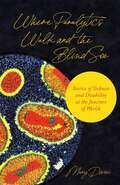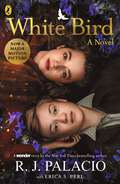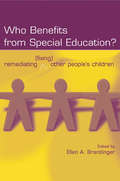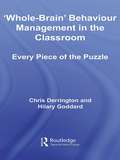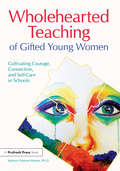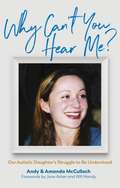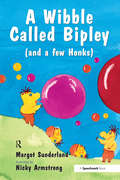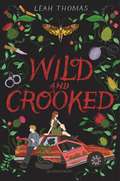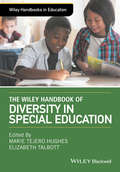- Table View
- List View
Where Paralytics Walk and the Blind See: Stories of Sickness and Disability at the Juncture of Worlds
by Mary DunnAn exploration of early modern accounts of sickness and disability—and what they tell us about our own approach to bodily differenceIn our age of biomedicine, society often treats sickness and disability as problems in need of solution. Phenomena of embodied difference, however, have not always been seen in terms of lack and loss. Where Paralytics Walk and the Blind See explores the case of early modern Catholic Canada under French rule and shows it to be a period rich with alternative understandings of infirmity, disease, and death. Counternarratives to our contemporary assumptions, these early modern stories invite us to creatively imagine ways of living meaningfully with embodied difference today.At the heart of Dunn’s account are a range of historical sources: Jesuit stories of illness in New France, an account of Canada’s first hospital, the hagiographic vita of Catherine de Saint-Augustin, and tales of miraculous healings wrought by a dead Franciscan friar. In an early modern world that subscribed to a Christian view of salvation, both sickness and disability held significance for more than the body, opening opportunities for virtue, charity, and even redemption. Dunn demonstrates that when these reflections collide with modern thinking, the effect is a certain kind of freedom to reimagine what sickness and disability might mean to us.Reminding us that the meanings we make of embodied difference are historically conditioned, Where Paralytics Walk and the Blind See makes a forceful case for the role of history in broadening our imagination.
Where Paralytics Walk and the Blind See: Stories of Sickness and Disability at the Juncture of Worlds
by Mary DunnAn exploration of early modern accounts of sickness and disability—and what they tell us about our own approach to bodily differenceIn our age of biomedicine, society often treats sickness and disability as problems in need of solution. Phenomena of embodied difference, however, have not always been seen in terms of lack and loss. Where Paralytics Walk and the Blind See explores the case of early modern Catholic Canada under French rule and shows it to be a period rich with alternative understandings of infirmity, disease, and death. Counternarratives to our contemporary assumptions, these early modern stories invite us to creatively imagine ways of living meaningfully with embodied difference today.At the heart of Dunn’s account are a range of historical sources: Jesuit stories of illness in New France, an account of Canada’s first hospital, the hagiographic vita of Catherine de Saint-Augustin, and tales of miraculous healings wrought by a dead Franciscan friar. In an early modern world that subscribed to a Christian view of salvation, both sickness and disability held significance for more than the body, opening opportunities for virtue, charity, and even redemption. Dunn demonstrates that when these reflections collide with modern thinking, the effect is a certain kind of freedom to reimagine what sickness and disability might mean to us.Reminding us that the meanings we make of embodied difference are historically conditioned, Where Paralytics Walk and the Blind See makes a forceful case for the role of history in broadening our imagination.
Where's Mummy Mouse?: Targeting the m Sound (Speech Bubbles 1)
by Melissa PalmerMolly mouse wakes to find her Mummy has vanished, so she sets off to find her – meeting some interesting creatures along the way. This picture book targets the /m/ sound, and is part of Speech Bubbles 1, a series of picture books that target specific speech sounds within the story. The series can be used for children receiving speech therapy, for children who have a speech sound delay/disorder, or simply as an activity for children’s speech sound development and/or phonological awareness. They are ideal for use by parents, teachers or caregivers. Bright pictures and a fun story create an engaging activity perfect for sound awareness. Please see other titles in the series for stories targeting other speech sounds.
Where's Mummy Mouse?: Targeting the m Sound (Speech Bubbles 1)
by Melissa PalmerMolly mouse wakes to find her Mummy has vanished, so she sets off to find her – meeting some interesting creatures along the way. This picture book targets the /m/ sound, and is part of Speech Bubbles 1, a series of picture books that target specific speech sounds within the story. The series can be used for children receiving speech therapy, for children who have a speech sound delay/disorder, or simply as an activity for children’s speech sound development and/or phonological awareness. They are ideal for use by parents, teachers or caregivers. Bright pictures and a fun story create an engaging activity perfect for sound awareness. Please see other titles in the series for stories targeting other speech sounds.
White Bird: A Wonder Story
by R J PalacioFrom the bestselling author of Wonder comes White Bird: now a major film starring Ariella Glaser, Orlando Schwerdt, Bryce Gheisar, Helen Mirren and Gillian Anderson.Sara Blum lives an idyllic life. But her world comes crashing down when the Nazi occupation arrives in her small French town, separating her from her parents and forcing the young Jewish girl into hiding. Sara's classmate Julien and his family will risk everything to ensure her survival, and together, Sara and Julien manage to find beauty in a secret world of their creation.Originally published as a graphic novel, and featuring characters from the multi-million-copy-bestselling phenomenon Wonder, Sara and Julien's powerful, heartbreaking and timeless story is told here for the first time as a novel, and shows the power of kindness to change hearts, build bridges, and even save lives in the darkest of times.Discover more from the World of Wonder:White Bird, the original graphic novel Auggie & Me365 Days of WonderWe're All Wonders And read more from R. J. Palacio with Pony, an unforgettable new story!
Who Benefits From Special Education?: Remediating (Fixing) Other People's Children (Studies in Curriculum Theory Series)
by Ellen A. BrantlingerWho Benefits From Special Education?: Remediating (Fixing) Other People's Children addresses the negative consequences of labeling and separating education for students with "disabilities," the cultural biases inherent in the way that we view children's learning difficulties, the social construction of disability, the commercialization of special education, and related issues.The theme that unifies the chapters is that tension exists between professional ideology and practice, and the wishes and expectations of the recipients of professional practice--children, adolescents, and adults with disabilities and their families. These voices have rarely taken center stage in formulating important decisions about the quality and characteristics of appropriate practice. The dominant view in the field of special education has been that disability is a problem in certain children, rather than an artifact that results from the general structure of schooling; it does not take into consideration the voices of people with disabilities, their families, or their teachers. Offering an alternative perspective, this book deconstructs mainstream special education ideologies and highlights the personal perspectives of students, families, and front-line professionals such as teachers and mental health personnel. It is particularly relevant for special education/disabilities studies graduate students and faculty and for readers in general education, curriculum studies, instruction theory, and critical theory.
Who Benefits From Special Education?: Remediating (Fixing) Other People's Children (Studies in Curriculum Theory Series)
by Ellen A. BrantlingerWho Benefits From Special Education?: Remediating (Fixing) Other People's Children addresses the negative consequences of labeling and separating education for students with "disabilities," the cultural biases inherent in the way that we view children's learning difficulties, the social construction of disability, the commercialization of special education, and related issues.The theme that unifies the chapters is that tension exists between professional ideology and practice, and the wishes and expectations of the recipients of professional practice--children, adolescents, and adults with disabilities and their families. These voices have rarely taken center stage in formulating important decisions about the quality and characteristics of appropriate practice. The dominant view in the field of special education has been that disability is a problem in certain children, rather than an artifact that results from the general structure of schooling; it does not take into consideration the voices of people with disabilities, their families, or their teachers. Offering an alternative perspective, this book deconstructs mainstream special education ideologies and highlights the personal perspectives of students, families, and front-line professionals such as teachers and mental health personnel. It is particularly relevant for special education/disabilities studies graduate students and faculty and for readers in general education, curriculum studies, instruction theory, and critical theory.
Who Bit My Tail?: Targeting the t Sound (Speech Bubbles 1)
by Melissa PalmerTiger wakes from a dream to find a big bite on his tail – but can he discover who is the culprit? This picture book targets the /t/ sound, and is part of Speech Bubbles 1, a series of picture books that target specific speech sounds within the story. The series can be used for children receiving speech therapy, for children who have a speech sound delay/disorder, or simply as an activity for children’s speech sound development and/or phonological awareness. They are ideal for use by parents, teachers or caregivers. Bright pictures and a fun story create an engaging activity perfect for sound awareness. Please see other titles in the series for stories targeting other speech sounds.
Who Bit My Tail?: Targeting the t Sound (Speech Bubbles 1)
by Melissa PalmerTiger wakes from a dream to find a big bite on his tail – but can he discover who is the culprit? This picture book targets the /t/ sound, and is part of Speech Bubbles 1, a series of picture books that target specific speech sounds within the story. The series can be used for children receiving speech therapy, for children who have a speech sound delay/disorder, or simply as an activity for children’s speech sound development and/or phonological awareness. They are ideal for use by parents, teachers or caregivers. Bright pictures and a fun story create an engaging activity perfect for sound awareness. Please see other titles in the series for stories targeting other speech sounds.
Who-Who-Who Goes Hoo-Hoo-Hoo
by Peter SchneiderThis beautifully illustrated storybook has been written for children who stutter and their parents, carers and teachers. It tells the story of a young hedgehog who stutters and his encounters with several woodland creatures, some of whom stutter and others who do not. In the end they all work together to defeat a monster who lurks in the wood. The story makes clear that it is more important to listen to what someone says rather than the way they say it. It offers a positive message to children who stutter and shows other people, both adults and children, how best to react when talking to a child who stutters and the kind of responses to avoid. The book includes information about stuttering for adults and list of relevant organisations.
Who-Who-Who Goes Hoo-Hoo-Hoo
by Peter SchneiderThis beautifully illustrated storybook has been written for children who stutter and their parents, carers and teachers. It tells the story of a young hedgehog who stutters and his encounters with several woodland creatures, some of whom stutter and others who do not. In the end they all work together to defeat a monster who lurks in the wood. The story makes clear that it is more important to listen to what someone says rather than the way they say it. It offers a positive message to children who stutter and shows other people, both adults and children, how best to react when talking to a child who stutters and the kind of responses to avoid. The book includes information about stuttering for adults and list of relevant organisations.
'Whole-Brain' Behaviour Management in the Classroom: Every Piece of the Puzzle
by Chris Derrington Hilary GoddardRepresenting a brave and insightful shift away from narrow perspectives on behaviour management, this book draws practitioners towards a more holistic understanding of ourselves and how we impact on children’s learning and behaviour. The authors’ brilliant new conceptual model of ‘whole-brain’ behaviour management challenges existing theories about the management of children’s behavioural issues. Their pioneering ‘whole-brain’ approach draws upon a range of influences and concepts that cross discipline boundaries, expanding on the practitioner’s understanding of the complexity of children’s behaviour through their own knowledge of neuroscience, biopsychosocial theory and interpersonal awareness. The book will take the reader through a process of self-evaluation in which their preferred ways of thinking, acting and relating will be explored and interpreted in order to help them understand the impact of their ‘personal style’ on how the children in their care behave. Offering new insights and creative solutions, this is a practical guide to coach practitioners in their personal and professional development, helping them to raise the achievement of children exhibiting even the most challenging of behaviour.
'Whole-Brain' Behaviour Management in the Classroom: Every Piece of the Puzzle
by Chris Derrington Hilary GoddardRepresenting a brave and insightful shift away from narrow perspectives on behaviour management, this book draws practitioners towards a more holistic understanding of ourselves and how we impact on children’s learning and behaviour. The authors’ brilliant new conceptual model of ‘whole-brain’ behaviour management challenges existing theories about the management of children’s behavioural issues. Their pioneering ‘whole-brain’ approach draws upon a range of influences and concepts that cross discipline boundaries, expanding on the practitioner’s understanding of the complexity of children’s behaviour through their own knowledge of neuroscience, biopsychosocial theory and interpersonal awareness. The book will take the reader through a process of self-evaluation in which their preferred ways of thinking, acting and relating will be explored and interpreted in order to help them understand the impact of their ‘personal style’ on how the children in their care behave. Offering new insights and creative solutions, this is a practical guide to coach practitioners in their personal and professional development, helping them to raise the achievement of children exhibiting even the most challenging of behaviour.
Wholehearted Teaching of Gifted Young Women: Cultivating Courage, Connection, and Self-Care in Schools
by Kathryn Fishman-WeaverWholehearted Teaching of Gifted Young Women explores the important role school communities play in supporting the social and emotional needs of high-achieving young women. Using a youth participatory action research model, this project follows 20 student researchers from high school through college. This longitudinal study leads to “Wholehearted Teaching,” a new framework for cultivating courage, connection, and self-care in schools. Framed with personal stories and filled with practical suggestions, this book offers strategies for teachers, counselors, parents, and high-achieving young women as they navigate the precipice of youth and everything after.
Wholehearted Teaching of Gifted Young Women: Cultivating Courage, Connection, and Self-Care in Schools
by Kathryn Fishman-WeaverWholehearted Teaching of Gifted Young Women explores the important role school communities play in supporting the social and emotional needs of high-achieving young women. Using a youth participatory action research model, this project follows 20 student researchers from high school through college. This longitudinal study leads to “Wholehearted Teaching,” a new framework for cultivating courage, connection, and self-care in schools. Framed with personal stories and filled with practical suggestions, this book offers strategies for teachers, counselors, parents, and high-achieving young women as they navigate the precipice of youth and everything after.
Why Can't You Hear Me?: Our Autistic Daughter's Struggle to Be Understood
by Andrew McCulloch Amanda McCullochIn the early hours of 28th July 2016, Colette McCulloch was hit by a lorry and killed on the A1. Eighteen hours earlier she had walked out of the specialist care facility for autistic adults where she was being treated. Here, Andy and Amanda McCulloch tell the story of their daughter's life and untimely death: the years in which her autism went undiagnosed, her lifelong battle with eating disorders and the lack of support for her complex needs. The book is interspersed with Colette's own vivid and eloquent writing, her poetry and prose articulating her experiences grappling with a world forever at odds with her. Colette's story is a call to action and ultimately leaves a message of hope for a future in which autistic people will be better understood and able to flourish.
Why Do You Do That?: A Book about Tourette Syndrome for Children and Young People
by Mary Robertson Uttom ChowdhuryThe authors describe tics and Tourette's in clear, child-friendly terms and provide a simple explanation of the biological causes. Other chapters focus on associated features such as obsessive-compulsive disorder, attention deficit/hyperactivity disorder and aggression. The authors also offer tips on how to deal with issues such as bullying.
Why Johnny Doesn't Flap: NT is OK! (PDF)
by Alex Merry Clay Morton Gail MortonJohnny is different. He is never exactly on time, he can't seem to stick to a routine and he often speaks in cryptic idioms. Johnny is neurotypical, but that's ok. A picture book with a difference, Why Johnny Doesn't Flap turns the tables on common depictions of neurological difference by drolly revealing how people who are not on the autistic spectrum are perceived by those who are. The autistic narrator's bafflement at his neurotypical friend's quirks shows that 'normal' is simply a matter of perspective.
A Wibble Called Bipley: A Story for Children Who Have Hardened Their Hearts or Becomes Bullies (Helping Children with Feelings)
by Margot SunderlandA story for children who have hardened their hearts or become bullies. Bipley is a warm cuddly creature, but someone has broken his heart. He feels so hurt that he decides it is just too painful to ever love again. When he meets some big tough Honks in the wood, they teach him how to harden his heart so that he doesn't have to feel hurt any more. Luckily Bipley meets some creatures who teach him how he can protect himself without hardening his heart.
Widerstreitendes Erzählen: Ambivalenzen im Kontext (inklusions-) pädagogischer Ansprüche
by Anne Weidermann Stephanie Winter Jens Geldner-Belli Tanja Kinne Mirko MollSonder- und Inklusionspädagogiken legitimieren sich unter Verweis auf kontingente, ambivalente und mitunter widerstreitende Vorstellungen von (Nicht-)Behinderungen. Die Aufmerksamkeit hierfür stellt eine große Herausforderung für disziplinäre und professionelle Selbstverständigungen dar. Der Band eröffnet eine Perspektive auf unterschiedliche Vorstellungen von (Nicht-)Behinderungen in ihrer Bedeutung für das Pädagogische. Zugleich geht er der Frage nach, welchen Beitrag das Konzept der Erzählung zu einer Annäherung an die Ambivalenzen im Kontext des Pädagogischen leisten kann.
Wild and Crooked
by Leah ThomasCritically-acclaimed author Leah Thomas blends a small-town setting with the secrets of a long-ago crime, in a compelling novel about breaking free from the past.In Samsboro, Kentucky, Kalyn Spence's name is inseparable from the brutal murder her father committed when he was a teenager. Forced to return to town, Kalyn must attend school under a pseudonym . . . or face the lingering anger of Samsboro's citizens, who refuse to forget the crime. Gus Peake has never had the luxury of redefining himself. A Samsboro native, he's either known as the "disabled kid" because of his cerebral palsy, or as the kid whose dad was murdered. Gus just wants to be known as himself. When Gus meets Kalyn, her frankness is refreshing, and they form a deep friendship. Until their families' pasts emerge. And when the accepted version of the truth is questioned, Kalyn and Gus are caught in the center of a national uproar. Can they break free from a legacy of inherited lies and chart their own paths forward?
The Wiley Handbook of Diversity in Special Education (Wiley Handbooks in Education)
by Marie Tejero Hughes Elizabeth TalbottThe Wiley Handbook of Diversity in Special Education is a state-of-the-art reference showcasing cutting-edge special education research with a focus on children and youth with disabilities from diverse cultural, ethnic, linguistic, and economic backgrounds. Cutting-edge special education research focusing on children and youth with disabilities from diverse cultural, ethnic, linguistic, and economic backgrounds An authoritative contribution to the field, this work charts a new path to effective interventions and sets an agenda for future research Addresses disabilities from an international perspective
The Wiley Handbook of Diversity in Special Education (Wiley Handbooks in Education)
by Marie Tejero Hughes Elizabeth TalbottThe Wiley Handbook of Diversity in Special Education is a state-of-the-art reference showcasing cutting-edge special education research with a focus on children and youth with disabilities from diverse cultural, ethnic, linguistic, and economic backgrounds. Cutting-edge special education research focusing on children and youth with disabilities from diverse cultural, ethnic, linguistic, and economic backgrounds An authoritative contribution to the field, this work charts a new path to effective interventions and sets an agenda for future research Addresses disabilities from an international perspective
A Will of His Own: Reflections on Parenting a Child with Autism - Revised Edition
by Kelly HarlandWill's anxieties and obsessions can dominate daily life, making a trip to the grocery store seem like a walk across a minefield. But amidst these unpredictable "flip-outs" there are moments of wonder. Kelly Harland's stories explore her son's life to the age of 14, and the unexpected universe she and her husband must learn to navigate with him.
William Wobbly and the Mysterious Holey Jumper: A story about fear and coping
by Rosie Jefferies Sarah NaishSometimes William Wobbly gets very anxious. When he is anxious he'll often turn to chewing his jumper or hiding under his school desk. But luckily his mum knows how to help cope with those wobbly feelings. This is the perfect story for any child who struggles to cope when worried and with destructive coping mechanisms.
